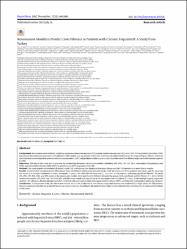Noninvasive Models to Predict Liver Fibrosis in Patients with Chronic Hepatitis B: A Study from Turkey

View/
Date
2017Author
Korkmaz, PınarDemirtürk, Neşe
Batırel, Ayşe
Yardımcı, Ahmet Cem
Çağır, Ünal
Nemli, Salih Atakan
Sayan, Murat
Dirgen Çaylak, Selmin
Metadata
Show full item recordAbstract
Background: Manynoninvasive methods, including aspartateaminotransaminase (AST)/alanineaminotransaminase (ALT) ratio (AAR), AST-to-platelet ratio index (APRI), Bonacini cirrhosis discriminant score (CDS), fibrosis-4 (FIB4) index, and age-platelet index (API), have been described to determine the stage of hepatic fibrosis. However, thesemethodsare developed for patients with chronic hepatitisC(CHC) andproduce conflicting results in the prediction of liver fibrosis in patients with chronic hepatitis B (CHB). Objectives: The aim of this study was to evaluate the relationship between 7 noninvasive models, including AAR, APRI, CDS, API, FIB-4, neutrophil-to-lymphocyte ratio (NLR), and red cell distribution width (RDW)-to-platelet ratio (RPR) in patients with CHB. Methods: The study population included all patients with CHB, undergoing liver biopsy to determine HBsAg and HBV DNA positivity in more than 6 months. Results: A total of 2520 treatment-naive CHB patients from 40 different centers were included in the study. In total, 62.6% of the patients were male, and the mean age was 40.60 +/- 12.34 years (minimum, 18 years; maximum, 77 years). The Ishak fibrosis score was >= 3 in 29.8% of the patients, indicating significant fibrosis. The mean API, APRI, CDS, NLR, FIB4, and RPR scores in the noninvasive models were significantly different between the groups with significant and low fibrosis (P < 0.05). All the noninvave models (API, APRI, AAR, CDS, NLR, RPR, and FIB4) were found to be significant in the discrimination of cirrhosis (P < 0.05). In the multiple logistic regression analysis, CDS, albumin, alkaline phosphatase (ALP), total bilirubin, neutrophil count, NLR, mean platelet volume (MPV), and FIB4 were independent indices for cirrhosis. Conclusions: In the present study, the role of noninvasive tests in the prediction of liver fibrosis stage and cirrhosis was evaluated in a large cohort of CHB patients. Overall, noninvasive models are gradually becoming more promising. Accordingly, the need for liver biopsy can be reduced with a combination of noninvasive methods in the future.

















